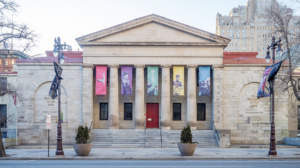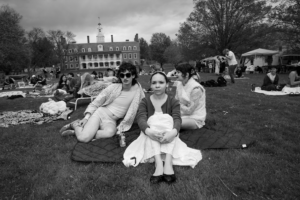
After several years of attempts at organization, members of the faculty, staff, and Campus Safety of Bennington College have successfully established a recognized union. Known as Bennington College United (BCU), the bargaining organization has officially been recognized by the American Federation of Teachers, one of the largest labor organizations in the United States.
Collective governance and bargaining are by no means a recent phenomenon for employees of the college; according to Benjamin Anastas, a long-time professor at the college and currently a member of BCU’s bargaining committee, Bennington College has a tradition of employee organization.
“[BCU] is the first official union at Bennington,” Anastas said during an interview in March. “The faculty at Bennington has had this de-facto union called Faculty Forum for a while, going back to Liz Coleman’s years, and it really was a union.”
Though not recognized by a larger labor organization, Faculty Forum was a long-standing institution designed to provide a clearer dialogue between employees of the college and its administrators, including the President and Board of Trustees. Faculty Forum, Anastas explained, was formed by faculty members in response to actions taken by the administration during the tenure of former president Elizabeth Coleman, whose controversial decisions regarding the college’s direction are still felt today.
The key difference between the Faculty Forum as it existed in the past and the contemporary Union is that the Faculty Forum did not represent the staff of the college; this disconnect meant a gap in communication and, ultimately, a weakening of the organization’s ability to participate in the governance of the college. Given the nature of college – a small institution with a fairly unusual pedagogy – radical changes to the structure of administration are somewhat common.
“There were some times over the past couple of years where if there was an office in crisis, staff would come to Faculty Forum to let faculty know what was happening,” Anastas said. “Two years ago, we found out all of a sudden that the Office of Institutional Advancement had shrunk from eighteen employees down to six. Staff were quite concerned about this, and came through Faculty Forum to tell us about what was happening.”
It was in response to events like this, where faculty became informed of administrative decisions by their consequences rather than by internal communications, that the need for an organized, recognized union became evident. The specifics of these crises were also of some concern to faculty; rumors of instability among the President’s cabinet has led some to report an increasing anxiety about the college’s administration.
The other factor which instigated the unionization was the effects of the COVID-19 pandemic on the college. According to a report by the Economic Policy Institute, the National Labor Relations Board (NLRB) saw a 53% increase in union election petitions in workplaces across the country. The crisis imposed by COVID-19 on employees in all industries was more than enough to promote the significant protections offered by organization, and Bennington was no exception.
“[BCU] has been trying to happen for a long time,” said union member Lua Piovano-Marcotte. “The fact there’s currently a sort of nationwide movement towards organization has really helped us sort of jazz up the moment.”
Beginning during the Spring 2023 semester, the process of creating BCU began by contacting a larger labor group; in this case, the AFT. With the guidance offered by AFT, alongside that of an outside organizer brought on to coordinate the union full-time, the founders of the movement set about laying the groundwork for what would become known as BCU. In this case, that meant one thing: meetings. Lots and lots of meetings.
In order to create an organization that was honestly and effectively dedicated to improving the working conditions of all of Bennington’s employees, it was necessary to first create an understanding of what challenges and setbacks the employees are facing.
One approach to creating this understanding was through individual meetings. The organizer brought on by BCU met with numerous members of the faculty and staff in order to determine what facets of their employment could be improved, and how. The other approach was through a survey sent to Bennington employees regarding their priorities. Of the 187 employees eligible for membership in BCU, the survey received 114 responses.
Key issues among respondents varied, but when asked what the single most important workplace issue was, issues regarding pay and workload surfaced at the top – comprising 36.8% and 25.4%, respectively. Other issues included health benefits, contract length, and retirement benefits.
Once these statistics had been gathered, it was possible for the original organizers to begin constructing a platform designed to address these issues in particular. Currently, the union is arranged in three separate bargaining groups, representing the faculty, staff, and members of Campus Safety. While these through groups will conduct contract negotiations separately, they are linked through BCU’s shared bargaining committee, meaning that negotiations will not be conducted in isolation. This separation into different groups was done at the instigation of the administration itself.
While the administration did have certain reservations, Anastas was quick to commend the administration itself for its cooperation.
“First of all, we really want to applaud the administration for voluntarily recognizing the union. They didn’t have to do that,” Anastas said. That being said, Anastas – himself a member of the bargaining committee – was not without reservations. “But the question is – okay, great, you recognize the union. Now is it time to sit down and bargain?”
As of right now, BCU remains involved in the negotiation process with the administration. With a considerable amount of ground to cover in terms of employee demands, attitudes remain high.
Against potential criticisms of the union, member Lua Piovano-Marcotte said that “All unions get the same bad press – we’re going to cost the college a bunch of money, run it into the ground, et cetera – but that’s exactly not the goal. We’re trying to make the college more sustainable, and to attract new people to the student body.”
Others, like Anastas, voiced optimism about the role of BCU going forward. While some at the College are concerned about the current status of the administration, or about the College’s financial prospect, Anastas believes that BCU – and organizations like it – are necessary to bringing stability.
“We have very strong students, very strong staff, a faculty who is deeply committed to the work of the college,” Anastas said. “We just want Bennington to be a better workplace. And if it’s a better workplace, more people are going to want to stay, to invest in the college, to invest in the students, to invest in the place. Right now Bennington’s financial model is to ask too much of its workers.”
And for a time, that strategy seemed to be survivable – if not sustainable. According to Anastas, though, that time has ended.
“It’s asking for a lot of sacrifice, and we’re all willing to sacrifice because this place is worth it. Because the students are worth it and because Bennington’s history is worth it,” Anastas said. “But, you know, there’s only so much sacrifice that any kind of worker is willing to do.”
BCU’s contract negotiations are expected to continue for the next several months. For further updates, please check the Bennington Lens.




Be First to Comment